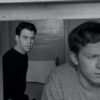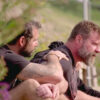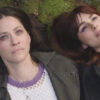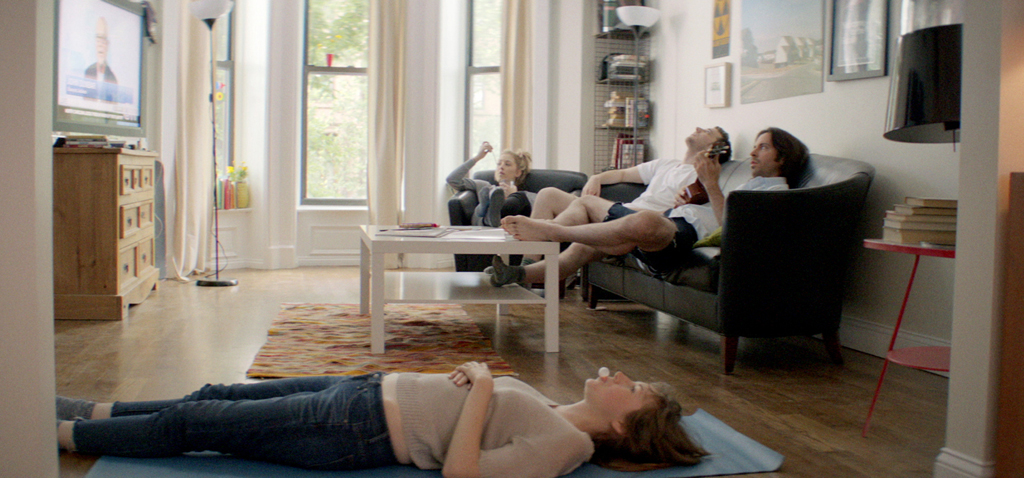Despite compiling an impressive reel of commercial work in recent years, it was when Andrew Zuchero hit a wall creatively in advertising that the seed was planted for his latest film.
“You have to sit at a desk and think about an idea that you want to come up with,” says Zuchero. “You do it for so long for the most inane projects and the most vapid products that it feels like your head is, at any second, going to blow up.”
Fortunately, the only explosion that Zuchero personally endured is the buzz that has accompanied “The Apocalypse,” the short that emerged from his brainstorming (or lack thereof) to premiere at Sundance earlier this year and will debut at SXSW this week [and can be seen below]. Featuring a host of familiar faces such as “Party Down” fave Martin Starr and Kate Lyn Sheil, the darkly funny film takes the writer/director’s head trauma and makes it literal for a group of twentysomethings lounging around a Brooklyn walkup on a lazy afternoon as the TV news reports the world may be coming to an end.
Not only can Zuchero credit his time in advertising with a bit of inspiration for the short, but also his ability to quickly establish the identity of his characters in the fleeting moments before chaos strikes, fully fleshing out a narrative that easily could’ve been one of the many casualties of “The Apocalypse”’s own killer joke. Shortly before Zuchero heads to Austin to enjoy some barbeque and Willie Nelson, he took the time to talk about the search for the perfect location for the film’s single setting, his love of practical special effects and how his older brother’s cold shoulder led him into directing.
I’m almost afraid to ask for fear your head might explode, but where did the idea come from?
Honestly, as a filmmaker who’s trying to write a longer movie, you really don’t have any idea of the voice you actually speak with or the way you want to tell a story is going to resonate with an audience at all or if they’re going to turn their noses up at it. So I just sat down and kind of attacked this from the perspective of what do I think is the funniest, stupidest, most from-the-gut thing I could make? And I’ll make it with the highest quality I can and put it out in the world and see if people respond to it. It’s been such a joy to see people think it’s funny.
The location is so central to the film. Did you build the script around a place you had in mind?
I had that spot in my brain exactly and I feel like what that spot is is if you turned 180 degrees from the set of “The Cosby Show” and looked the other way, that’s what you’d be looking at —three beautiful bay windows that look out onto Brooklyn. We couldn’t find anywhere.
We were thinking of maybe building it on a sound stage until I just got on my bicycle and rode around Park Slope and looked for any empty bay window I could find. We would leave a little note up on the door and a bunch of owners contacted us. We told them that we were going to destroy their apartment, just blood everywhere. Luckily, there was one guy who was kind of a contractor and he snuck it in under the owner’s radar. He had like a fake Italian, tough guy accent and was like, “If you promise me that you’re going to return it to the order in which it came, then you can do whatever you want.” The day after the shoot when I looked around the apartment, there was just blood caked everywhere and I saw the end of my life flash before my eyes. I got a bucket and a mop and just went crazy.
Since it must’ve been a process of trial and error, how did you find the best way to make those heads explode?
After I got out of school, how I didn’t starve to death was doing effects for friends’ films, so I do have an effects background. I admire the special effects pre-Jurassic Park so much. Like Jim Henson, Robert Zemeckis before he went CG, even just the little hand in Ewok or Yoda is just so amazing because it’s real. It’s actually there. So the way we approached all the special effects in the short was to do everything on set. We didn’t want to create anything in post and bring it in.
What that means basically is you have a motion control camera rig that turns a tripod into a robot and if you jiggle the camera around and do a crazy movement, it records the movement and then can play back the movement with the tripod over and over and over again. You’ll get six shots that are all moving exactly precisely in the same way, at the same speed, then what you can do is basically shoot many, many different elements and go into post and composite them together.
All the head explosions were just a mix of different things that we actually shot on set. One thing was just an actor screaming and falling over. Another thing is we’d take the actor into makeup, put scar wax all over their face and have them jump back as if their head just exploded and shoot that. Then we’d get an air cannon filled with blood and guts, fire it off and we’d throw wigs and hats into the air and make it look like all this crap is flying everywhere. We were trying to be very, very specific with what we were loading our air cannons with. We wanted to try and replicate how much matter is contained in the human brain, so there was about ten pounds of weird stuff that we jammed into an air cannon. I know in “Jerry Maguire,” that kid says a human head weighs eight pounds. It’s actually closer to 10 or 12.
It’s a really strong one-gag premise, but you can feel the world getting bigger and bigger as the film goes on. Was it difficult to limit yourself in the storytelling?
You pick one thing and even if it becomes epically large, if it still revolves around one thing, it has that satisfying feeling that it’s something simple. The point you just brought up there is something I really respond to when I look at really good cartoons, like Looney Tunes. They’re so concise in the way that the details that go into their stories. A lot of really good ones like “Duck Amok,” that cartoon where Bugs Bunny is fucking around with Daffy with the pencil, it’s one gag but they execute it perfectly and they let everything resolve around that. That’s a good lesson from the old genius cartoon guys.
Is that one of the things that got you interested in filmmaking to begin with?
It’s tough for me to remember. There were a couple things. One was that I was just mesmerized with movies ever since I was a little kid. The first movie [I saw] — I don’t even remember seeing it — was “Song of the South” with Brer Rabbit. My parents took me to it and they thought it was going to be a disaster because I think I just turned two. I was a horror as a kid and they thought I was just going to go wild and freak out, throw a tantrum or something. Then they put me on the seat, I wasn’t even big enough to weigh the seat down at the movie theater, so they had to put both their hands on it to push it down, but the moment that the curtains opened and that guy starts singing “Zippidee Do Da,” that was it. I was coldclocked out. Just silent as a mouse. Also, my grandfather was a projectionist at that theater and he would take me up to the projection room and like show me movies. It was like “Cinema Paradiso.” I guess that’s kind of the ridiculously cinematic of a reason why I got into filmmaking.
Were physical effects a big draw?
Yeah. I’ve got an older brother and I remember he was making a movie with all his friends as like a wizard movie. He was into those weird Dungeons & Dragons books. So was I, but he was making a movie with all his buddies, with all these special effects and fun stuff going on. I was like, “Hey, can I help out?” And he was like, “No,” and called me a doofus or something. All his buddies are out making a movie and I was like, “Fuck these guys. I’m going to go make my own movie.” That was probably more of a formative moment is when the older brother was like get the hell out of here.
“The Apocalypse” will play at SXSW on Saturday, March 9th at 9 p.m. at the Rollins Theatre at the Long Center, Thursday, March 14th at 9:45 p.m. at the Vimeo Theater and Saturday, March 16th at 11:59 p.m. at the Topfer Theatre at the Zach Scott. If you’re not in Austin, it can be watched online here.




